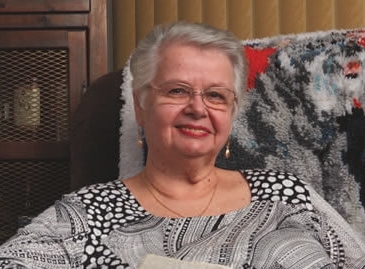“I carry myself much better without any fear of falling.”

When Irene Blackburn began to lose strength in her muscles and started to feel off-balance, she just accepted it as the normal progression of Parkinson’s disease.
“My balance was so bad, I thought I would end up needing to use a wheelchair. I felt like I was tipsy because I would lean to the right side,” said Mrs. Blackburn, 67, of Manville, who was diagnosed two years ago with Parkinson’s disease. The neurodegenerative brain disorder causes the brain to stop producing dopamine, a neurotransmitter, which results in loss of control of body movements.
Falling was a constant fear for Mrs. Blackburn. Her leg muscles were so weak she needed help to get up out of a chair. She gave up doing her favorite arts and crafts because her hands and fingers weren’t strong enough to hold a paintbrush or sewing needle.
Then she participated in a specialized rehabilitation program for individuals with Parkinson’s disease called LSVT BIG®, which is offered by certified therapists from the physical therapy outpatient service on the New Brunswick, Somerset and Hamilton campuses of Robert Wood Johnson University Hospital (RWJ).
After completing five weeks of physical therapy and occupational therapy, both a part of the LSVT BIG program at RWJ Somerset, “I feel like a whole new person,” Mrs. Blackburn said.
“Our goal is to minimize the effects of Parkinson’s and delay the deterioration,” said Maria Halka, Mrs. Blackburn’s occupational therapist. “Patients tend to perform movements in a slow, hesitant way and we work with them to amplify their movements to help them to get back to doing the things they love to do.”
A typical treatment plan includes four sessions a week for four weeks – half of which are physical therapy sessions and half that are occupational therapy sessions. Patients also learn exercises to complete every day at home.
I walk with a much stronger determination,” she said. “I carry myself much better without any fear of falling.”
“We teach patients that in everything they do, from taking steps to writing their name, they need to think big,” said Venus Rivera, a physical therapist who worked with Mrs. Blackburn. “Because of the way Parkinson’s disease affects their muscles and movement, patients need to use more effort and make bigger movements in order to do their normal daily activities.”
Some patients with Parkinson’s disease may also require specialized speech therapy called LSVT LOUD®, which is also offered by RWJ’s outpatient physical therapy services and offered on both campuses also.
Over the course of 16 sessions in a month, patients are taught exercises to stimulate the voice box muscles.
“LSVT LOUD is the best evidence-based program for voice and speech for patients with Parkinson’s disease,” said Katie Holterman, coordinator of speech and language services at RWJ Somerset. “Patients talk louder, develop clearer speech, slow down their rate of speech and improve their vocal quality so they are more easily understood when they are communicating with others.”
Following her therapy, Mrs. Blackburn built up her hand strength enough to begin rugweaving again. She uses a cane for walking but has regained her balance. With stronger leg muscles, she can easily get up and down from a chair by herself.
“I walk with a much stronger determination,” she said. “I carry myself much better without any fear of falling.”
Mrs. Blackburn continues to do exercises for about 30 minutes a day at home and swims three days a week at a Hillsborough fitness center.
“I really feel like I’m living again,” she said.